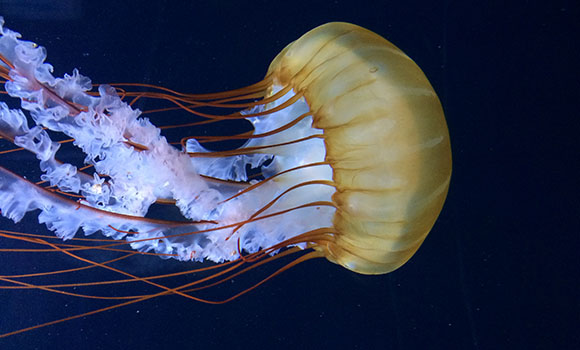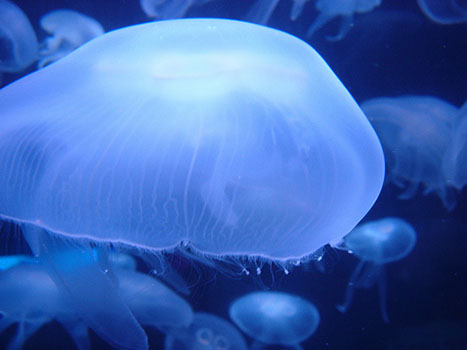It's not hard to get lost in the hypnotic lure of jellies, whose graceful movements, peaceful demeanor and stunning appearance have a calming effect on many people.

By Mallory Johnson
Published: February, 2016
It’s not hard to get lost in the hypnotic lure of jellies, whose graceful movements, peaceful demeanor and stunning appearance have a calming effect on many people. It’s no wonder these spineless wonders are an aquarium favorite. Jellies are mesmerizing animals with amazing attributes. Check out these 15 fascinating facts about jellies to learn more about what makes them so remarkable.
1. Worldwide, there are over 200 species of jellies.
2. Jellies are brainless, boneless and 95 percent liquid, but have four stomachs.
3. A group of jellies is called a smack.
4. Jellies have inhabited earth longer than almost any other species, dating back over 650 million years.
5. Despite their popular nickname, jellies have no gills and therefore are not actually fish.
6. Jellies are invertebrates with stinging cells, also known as cnidarians. They are more closely related to sea anemones and corals than they are to fish.
7. Jellies have two layers of skin, an outer ectoderm and an inner endoderm.
8. Jellies get their name from a substance called mesoglea, which has the appearance and feel of jelly. Mesoglea provides structural support in lieu of bones or cartilage.
9. Jellies have little control over their own movement. Their bodies pulsate, but their movement is primarily controlled by ocean currents.
10. Jellies have no brain, but rather primitive nerve nets throughout their bodies that control their limited motion.
11. Moon jellies clone themselves through a process called strobilation, in which a polyp will divide itself into multiple segments before tiny clones float away and develop into genetically identical adults.
12. Sea nettles have long oral arms equipped with stinging cells, called nematocysts, that immobilize their prey.
13. Jellies’ oral arms can begin digesting food before it even reaches their mouths.
14. Jellies typically feed on larval fishes, zooplankton and even other jellies.
15. Jelly species are being affected by climate change. Jellies thrive in warmer waters, so as water temperature rises, so do jelly populations, causing an imbalance in ocean ecosystems. As jelly blooms grow, some adult fish populations become depleted as a result of more jellies consuming so many fish eggs and larvae.
You can learn more about jellies, and see multiple species in person including Atlantic and Pacific sea nettles, spotted lagoon jellies and moon jellies when you visit Aquarium of the Bay. Learn more at www.aquariumofthebay.org.
Mallory Johnson is the Communications Manager at Aquarium of the Bay, a nonprofit dedicated to protecting, restoring and inspiring the conservation of San Francisco Bay and its watershed.


